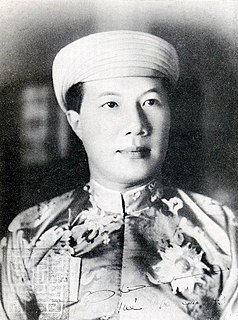 W
WBảo Đại, born Nguyễn Phúc Vĩnh Thụy, was the 13th and final emperor of the Nguyễn dynasty, the last ruling family of Vietnam. From 1926 to 1945, he was emperor of Annam, which was then a protectorate in French Indochina, covering the central two thirds of the present-day Vietnam. Bảo Đại ascended the throne in 1932.
 W
WĐặng Thùy Trâm was a Vietnamese doctor. She worked as a battlefield surgeon for the People's Army of Vietnam and Vietcong during the Vietnam War. Her wartime diaries, which chronicle the last two years of her life, attracted international attention following their publication in 2005.
 W
WMadame Nguyễn Thị Định was the first female general of Vietnam People's Army during the Vietnam War. Her role in the war was as National Liberation Front deputy commander, and was described as "the most important Southern woman revolutionary in the war". Furthermore, she was commander of an all-female force known as the Long-Haired Army, which engaged in espionage and combat against ARVN and US Forces.
 W
WThích Quảng Đức was a Vietnamese Mahayana Buddhist monk who burned himself to death at a busy Saigon road intersection on 11 June 1963. Quảng Đức was protesting the persecution of Buddhists by the South Vietnamese government led by Ngô Đình Diệm, a staunch Roman Catholic. Photographs of his self-immolation were circulated widely around the world and brought attention to the policies of the Diệm government. John F. Kennedy said in reference to a photograph of Quảng Đức on fire, "No news picture in history has generated so much emotion around the world as that one." Malcolm Browne won a Pulitzer Prize for his photograph of the monk's death.
 W
WDương Văn Minh, popularly known as Big Minh, was a South Vietnamese politician and a senior general in the Army of the Republic of Vietnam (ARVN) and a politician during the presidency of Ngô Đình Diệm. In 1963, he became chief of a military junta after leading a coup in which Diệm was assassinated. Minh lasted only three months before being toppled by Nguyễn Khánh, but assumed power again as the fourth and last President of South Vietnam in April 1975, two days before surrendering to North Vietnamese forces. He earned his nickname "Big Minh", because at approximately 1.83 m (6 ft) tall and weighing 90 kg (198 lb), he was much larger than the average Vietnamese.
 W
WTrịnh Thị Ngọ, also known as Thu Hương and Hanoi Hannah, was a Vietnamese radio personality best known for her work during the Vietnam War, when she made English-language broadcasts for North Vietnam directed at United States troops.
 W
WLe Ly Hayslip is a Vietnamese-American writer, memoirist and humanitarian. Through her foundations, she has worked to rebuild cultural bridges between Vietnam and America following the Vietnam War.
 W
WHồ Chí Minh, born Nguyễn Sinh Cung, also known as Nguyễn Tất Thành, Nguyễn Ái Quốc, Bác Hồ, or simply Bác, was a Vietnamese revolutionary and politician. He served as Prime Minister of North Vietnam from 1945 to 1955 and President from 1945 until his death in 1969. Ideologically a Marxist–Leninist, he served as Chairman and First Secretary of the Workers' Party of Vietnam.
 W
WHồ Văn Nhựt was a medical doctor who founded the Southern branch of Red Cross of Vietnam and a South Vietnamese opposition leader during and after the period of resistance against colonialism.
 W
WHoàng Cơ Minh was the first chairman of the Reform Revolutionary Party of Vietnam or Việt Tân. He was elected on 10 September 1982, when the Việt Tân was founded. Many Vietnamese expatriates consider him to have been a leader of the anti-communist resistance against the Vietnamese government.
 W
WHoàng Văn Hoan was a personal friend of Ho Chi Minh, a founding member of the Indochinese Communist Party, and a Politburo member of the Lao Dong Party from 1960 to 1976. Born in Nghệ An Province in 1905, Hoan was a crucial link between the Democratic Republic of Vietnam and China, ambassador to Beijing 1950–1957, and leader of many delegations to China as Vice Chairman of the DRV National Assembly Standing Committee in the 1960s. Known for his pro-Chinese sympathies, Hoan reached the peak of his career in the early 1960s when North Vietnam temporarily adopted a pro-Chinese attitude in the Sino-Soviet dispute.
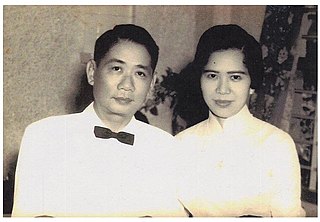 W
WHoàng Gia Hợp was a prominent Vietnamese-French medical doctor. He was a pioneering medical professional in Vietnam from the 1930s until his retirement in the 1990s.
 W
WNguyễn Lê Trần, also known as Madame Khánh, is the widow of Nguyễn Khánh, former South Vietnamese General and politician, who served as Prime Minister and Chief of State of South Vietnam from 1964 to 1965. As First Lady of South Vietnam, she visited hospitals to give moral support to wounded military and she also accompanied her husband on numerous engagements at state affairs.
 W
WKhương Hữu Điểu was a South Vietnamese Government ranking cabinet member and banking chief executive officer in the South Vietnam government from the mid 1950s to 1975.
 W
WLê Đức Anh was a Vietnamese politician and general who served as the fourth President of Vietnam from 1992 to 1997. He previously led the Vietnamese forces in Cambodia throughout the 1980s. He was regarded as a conservative who advocated maintaining tight party control over domestic policies.
 W
WLê Duẩn was a Vietnamese communist politician. He rose in the party hierarchy in the late 1950s and became General Secretary of the Central Committee of the Communist Party of Vietnam (VCP) at the 3rd National Congress in 1960. He continued Hồ Chí Minh's policy of ruling through collective leadership. From the mid-1960s until his own death in 1986, he was the top decision-maker in Vietnam.
 W
WLê Đức Thọ, born Phan Đình Khải in Nam Dinh Province, was a Vietnamese revolutionary, general, diplomat, and politician. He was the first Asian to be awarded the Nobel Peace Prize, jointly with United States Secretary of State Henry Kissinger in 1973, but refused the award.
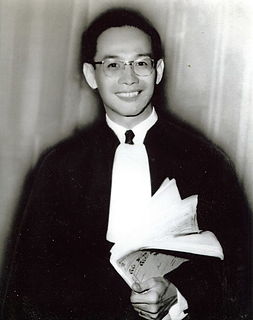 W
WTrần Ngọc Liễng was a Vietnamese prominent Attorney-at-Law and a pioneer law scholar in Vietnam for over 70 years from the 1930s until his retirement at the end of the last millennium.
 W
WKhương Hữu Long was a Vietnamese prominent French Medical Doctor – A Pioneer Medical Professional in Vietnam for over 70 years from the 1930s until his retirement at the end of the last millennium.
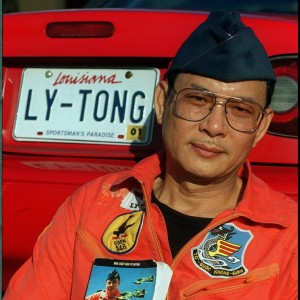 W
WLê Văn Tống, known as Lý Tống, was a Vietnamese American anti-communist activist.
 W
WNăm Cam was a notorious Vietnamese mobster who is often called the "Godfather" of Vietnam. Known for building and running a criminal enterprise revolving around gambling dens, hotels, racketeering, extortion, loan sharking and restaurants that fronted for brothels, during his heyday, Năm Cam was considered one of the most powerful mob bosses in Vietnam, and was said to have attained influence that even extended into the ranks of Vietnam's Communist Party which he used to his advantage by bribing law enforcement and government officials to protect his lucrative enterprise and cover up his murders of other criminal rivals in Saigon that challenged his reign. In fact, his connection and ties with the Vietnam's Communist Party was so tight that during his trial, 153 other people that were tried with him were high ranking officers of the Communist Party.
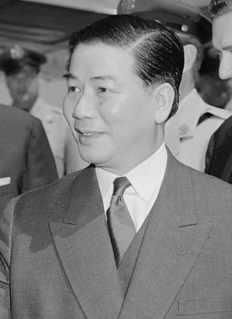 W
WNgô Đình Diệm was a Vietnamese politician. He was the final prime minister of the State of Vietnam (1954–55), and then served as President of South Vietnam from 1955 until he was captured and assassinated during the 1963 military coup.
 W
WNgô Đình Cẩn was a younger brother and confidant of South Vietnam's first president, Ngô Đình Diệm, and an important member of the Diệm government. Diệm put Cẩn in charge of central Vietnam, stretching from Phan Thiết in the south to the border at the 17th parallel, with Cẩn ruling the region as a virtual dictator. Based in the former imperial capital of Huế, Cẩn operated private armies and secret police that controlled the central region and earned himself a reputation as the most oppressive of the Ngô brothers.
 W
WNgô Đình Nhu was a Vietnamese archivist and politician. He was the younger brother and chief political advisor of South Vietnam's first president, Ngô Đình Diệm. Although he held no formal executive position, he wielded immense unofficial power, exercising personal command of both the ARVN Special Forces and the Cần Lao political apparatus which served as the regime's de facto secret police.
 W
WNguyễn Văn Lém, often referred to as Bảy Lốp, was a member of the Viet Cong. He was summarily executed in Saigon during the Tet Offensive in the Vietnam War, when the Viet Cong and North Vietnamese forces launched a massive surprise attack. Lém was alleged to have murdered a colonel and eight members of his family before being captured.
 W
WPhanxicô Xaviê Nguyễn Văn Thuận or Francis-Xavier Nguyễn Văn Thuận, was a Cardinal in the Roman Catholic Church. He was a nephew of South Vietnam's first president, Ngô Đình Diệm, and of Archbishop Ngô Đình Thục.
 W
WĐặng Tuyết Mai, also known as Madame Nguyễn Cao Kỳ was the former wife of Nguyễn Cao Kỳ, former Republic of Vietnam Air Force commander and politician, who served as Prime Minister of South Vietnam from 1965 to 1967, and then as Vice President until his retirement from politics in 1971.
 W
WNguyễn Cao Kỳ was a Vietnamese military officer and politician who served as the chief of the Republic of Vietnam Air Force in the 1960s, before leading the nation as the prime minister of South Vietnam in a military junta from 1965 to 1967. Then, until his retirement from politics in 1971, he served as vice president to bitter rival General Nguyễn Văn Thiệu, in a nominally civilian administration.
 W
WNguyễn Hợp Đoàn was to be the last Mayor of Saigon, the capital of South Vietnam and Governor of Gia Dinh Province, before the fall of Saigon that led to the reunification of Vietnam under the Communist party in 1975.
 W
WNguyễn Văn Trỗi was a Việt Cộng Patriot. He gained notoriety after being captured by South Vietnamese forces while trying to assassinate United States Secretary of Defense Robert McNamara and Ambassador Henry Cabot Lodge Jr. who were visiting South Vietnam in May 1964.
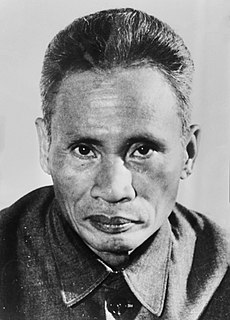 W
WPhạm Văn Đồng was a Vietnamese politician who served as Prime Minister of North Vietnam from 1955 to 1976. He later served as Prime Minister of Vietnam following reunification of North and South Vietnam from 1976 until he retired in 1987 under the rule of Lê Duẩn and Nguyễn Văn Linh. He was considered one of Hồ Chí Minh's closest lieutenants.
 W
WMajor General Phạm Văn Phú was an officer in the Army of the Republic of Vietnam. He was a graduate of the 8th class of the Dalat Military Academy in 1954.
 W
WPhan Huy Quát served as acting Prime Minister of the State of Vietnam and also as Prime Minister of the Republic of Vietnam.
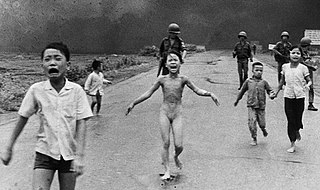 W
WPhan Thị Kim Phúc, referred to informally as the Napalm girl, is a South Vietnamese-born Canadian woman best known as the nine-year-old child depicted in the Pulitzer Prize-winning photograph taken at Trảng Bàng during the Vietnam War on June 8, 1972. The well-known photo, by AP photographer Nick Ut, shows her at nine years of age running naked on a road after being severely burned on her back by a South Vietnamese napalm attack.
 W
WTrương Như Tảng was a Vietnamese lawyer and politician. He was active in many anti-South Vietnamese organizations before joining the newly created Provisional Revolutionary Government of the Republic of South Vietnam as the Minister of Justice. He spent many years in the jungles near and in Cambodia until the Fall of Saigon in 1975. He quickly became disillusioned with the newly imposed North Vietnamese regime and escaped the reunited Socialist Republic of Vietnam via a boat in August 1978. He was sent to a refugee camp in Indonesia before moving to Paris, France, to live out his life in exile.
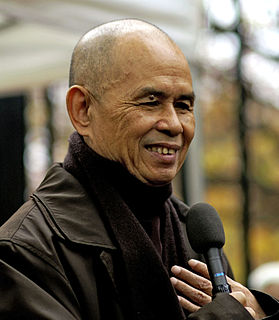 W
WThích Nhất Hạnh is a Vietnamese Thiền Buddhist monk, peace activist, and founder of the Plum Village Tradition, historically recognized as the main inspiration for engaged Buddhism.
 W
WMadame Nguyễn Văn Thiệu served as First Lady of South Vietnam from 1967–75. She is the widow of Nguyễn Văn Thiệu, a Vietnamese general and politician, who served as President of the Republic of Vietnam from 1967 until his resignation in 1975.
 W
WNguyễn Ngọc Thơ was a Vietnamese politician who was the first Prime Minister of South Vietnam, serving from November 1963 to late January 1964. Thơ was appointed to head a civilian cabinet by the military junta of General Dương Văn Minh, which came to power after overthrowing and assassinating Ngô Đình Diệm, the nation's first president. Thơ's rule was marked by a period of confusion and weak government, as the Military Revolutionary Council (MRC) and the civilian cabinet vied for power. Thơ lost his job and retired from politics when Minh's junta was deposed in a January 1964 coup by General Nguyễn Khánh.
 W
WTôn Thất Thiện (1924-2014) was a South Vietnamese nationalist of the post-World War II generation who had the rare distinction of serving and watching at close quarters the two historic leaders of post-World War II Vietnam: presidents Ho Chi Minh in the Viet Minh coalition in 1945–46, and Ngô Đình Diệm 1954–55/1956–59/1963. He played a significant though understated role in the nationalist attempt to preserve a non-communist Vietnam.
 W
WTrần Đại Nghĩa was a Vietnamese scientist, military engineer, and prominent figure in the defense industry of Vietnam. He was a major-general and an academician. He was awarded the Order of Ho Chi Minh and named a Hero of Labor. He was elected as an Academician to the former USSR Academy of Sciences.
 W
WTrần Văn Hương was a South Vietnamese politician who was the penultimate president of South Vietnam for a week in April 1975 prior to its surrender to the communist forces of North Vietnam. Prior to that, he was prime minister for three months from November 1964 to January 1965 under the supervision of a military junta led by General Nguyen Khanh; during this time, there was widespread civil unrest from the Buddhist majority and power struggles with the military.
 W
WTrần Văn Lắm, also known as Charles Trần Văn Lắm, was Minister for Foreign Affairs for the Republic of Vietnam during the height of the Vietnam War.
 W
WTrường Chinh was a Vietnamese communist political leader and theoretician. He was one of the key figures of Vietnamese politics. He played a major role in the anti-French colonialism movement and finally after decades of protracted war in Vietnam, the Vietnamese defeated the colonial power. He was the think-tank of the Communist Party who determined the direction of the communist movement, particularly in the anti-French colonialism movement. After the declaration of independence in September 1945, Trường Chinh played an important role in shaping the politics of the Democratic Republic of Vietnam (DRV) and creating the socialist structure of the new Vietnam.
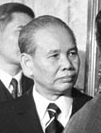 W
WXuân Thủy was a North Vietnamese political figure. He was the Foreign Minister of North Vietnam from 1963 to 1965 and then chief negotiator of the North Vietnamese at the Paris Peace talks.